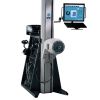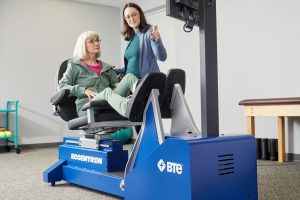
Pain Science: A Multidimensional Approach to Pain
Treatment GuidelinesPain science addresses the complex experience of pain beyond the physical effects – the emotional, psychological, and social ripple effects it can have on our patients' lives.
Pain is at the root of many therapy sessions, whether you’re trying to relieve pain or educate patients to avoid future episodes. At first, we think of pain as a physical experience. It manifests in many ways, from sharp, shooting pain to dull, achy, or maybe even a burning sensation.
However, when we dive deeper into pain science, we begin to understand the ripple effect that pain has in our patients’ lives. Not only physically, but it can also be felt emotionally, psychologically, socially, etc. We’ll take a deeper dive into this multidimensional approach to pain and recovery in this article.
What Is Pain Science?
Pain science addresses the complex experience of pain beyond the physical effects. One of the great leaders of this clinical movement is world-renowned physiotherapist, Greg Lehman. Lehman is an educator and clinical expert in pain and biopsychosocial behavior, with over 20 peer-reviewed research papers.
Lehman describes pain as, “a distressing experience associated with actual or perceived tissue damage with sensory, emotional, cognitive and social components”. As healthcare continues to evolve, clinicians are becoming more aware of the multifactorial components of pain. Pain is no longer considered only a physical experience. Before we jump to the multifactorial nature of pain, let’s first review what pain is, and why we have it.
Why Do We Feel Pain?
We experience pain thanks to little receptors throughout our bodies, called nociceptors. Nociceptors sense and respond to noxious (pain-inducing) stimuli by sending signals to the spinal cord. The spinal cord can relay that signal to the brain, which we then register as a feeling of pain.
This response is important in the early pain cycle to help us avoid noxious stimuli and create further tissue damage. However, the longer our bodies experience pain, we can become more sensitive to these stimuli.
How Pain Becomes Multidimensional
Let’s dive deeper into that idea – the longer we experience pain, the more multidimensional it becomes. While pain begins as physical, it affects other dimensions of our lives as it progresses. These other dimensions include our social, psychological, and emotional wellness.
For example, take a 42-year-old mother who had a knee injury. First, she felt the physical pain of injuring her knee. This could have been an audible pop, swelling, sharp shooting pain, etc. With the help of her nociceptors, she avoids injuring it further by avoiding certain activities. She limits her use of stairs, driving, and walking for long periods.
Six weeks later, she still experiences moderate pain with certain activities and movements. Because long periods of driving and standing are painful, she doesn’t attend her child’s soccer games. She misses out on her usual exercise of bike riding. She experiences pain while shopping at the grocery store or even walking around her house.
These compounding effects take a toll on her social, psychological, and emotional wellbeing, in addition to the physical pain. While the physical pain stays the same or worsens, its effect spreads. Without her usual activities, she may experience increased stress, loneliness, depression, and may even lose hope for getting back to normal.
Addressing Pain in Your Practice
As clinicians, we are highly skilled at addressing physical side of chronic pain. But to have a patient-centered practice, you must be aware of these multidimensional effects of pain and injury. A truly comprehensive approach to treatment considers all these factors.
Let’s return to our example of the mother whose life flipped upside-down from knee pain. How can we use this multidimensional approach to help her return to the life she wants to live? A great place to start is motivational interviewing (MI).
Motivational Interviewing To Address Multidimensional Pain
Motivational interviewing is a technique utilized by many professionals, including healthcare practitioners. MI involves questions designed to drive motivation from within the patient to change negative behavior. It’s built on five pillars:
- Expressing empathy
- Developing discrepancy
- Avoiding arguments and confrontations
- Adjusting to client resistance
- Supporting a client’s self-efficacy and optimism.
Asking her open-ended questions like, “I understand you have been having pain recently, how can I best help you achieve your goals?” Or, “How can I help make this session a positive experience for you today?” Or how about, “If you can picture your life without pain, what would that look like?”
These types of questions express empathy and encourage self-motivation. They may lead to additional questions that help us recognize and adjust to any resistance from the patient. On the other hand, yes / no questions do the opposite. These simple questions limit our abilities for a successful outcome.
Addressing motivation helps build compliance and self-efficacy. The patient can build a clear goal of living pain-free and improving their quality of life. These are just a few examples of techniques you can use to improve your MI skills, and I’ve included some additional resources below.
Conclusion
Our goal is to best serve our patients by improving their quality of life and helping them return to function. By focusing on just the physical dimension of pain, you are limiting yourself. We can improve patient outcomes by addressing the whole patient. This becomes more evident when dealing with chronic pain, which is more likely to impact many areas of people’s lives.
Resources for Pain Science
To learn more about pain science in clinical practice, I highly recommend reading Greg Lehman’s book, Recovery Strategies. Download it for free on his website. Another informative book is Motivational Interviewing: Helping People Change, by Stephen Rollnick and William Richard Miller. Lastly, if you have a MedBridge account, you can get Continuing Education credits with their Motivational Interviewing courses.
Justin Melson, PT, DPT is a Physical Therapist and freelance healthcare content writer. He has been contributing content since 2020 for numerous healthcare start-ups and healthcare magazines. Writing allows him to share information with a greater audience as well as blend his passion for healthcare and helping others. Feel free to reach out on: theptunicorn LinkedIn, and UpWork.
References
- Dubin, A., et al. 2010. Nociceptors: the sensors of the pain pathway. Journal of Clinical Investigation. https://www.ncbi.nlm.nih.gov/pmc/articles/PMC2964977/
- Henderson, W. 2017. Five Principles of Motivational Interviewing/ Career Trends. https://careertrend.com/five-principles-motivational-interviewing-16358.html






